EXPRESS OF AUTODESK2023
Blocks
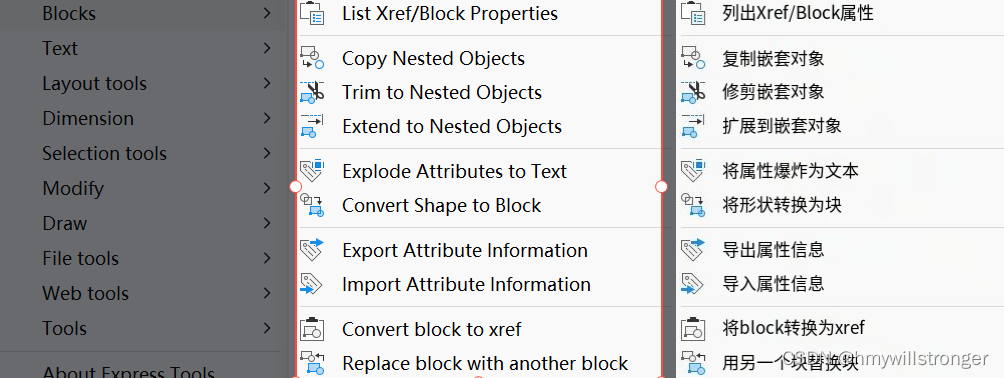
List Xref/Block Properties
This tool allows you to view and manage the properties of xrefs (external references) and blocks in your drawing. You can access information such as file paths, insertion points, scale factors, and more.
Copy Nested Objects
Use this tool to copy objects that are nested within blocks or xrefs. It enables you to select and copy specific objects without the need to explode the block or xref.
Trim to Nested Objects
This tool enables you to trim lines or polylines to nested objects within blocks or xrefs. It allows you to perform trimming operations without exploding the block or xref.
Extend to Nested Objects
Similar to “Trim to Nested Objects,” this tool allows you to extend lines or polylines to nested objects within blocks or xrefs, without the need to explode the block or xref.
Explode Attributes to Text
Use this tool to convert attribute objects within a block to standard text objects. This can be useful when you need to edit or manipulate the attribute text independently of the block.
Convert Shape to Block
This tool converts a selected shape (such as a polygon or a closed polyline) into a block definition. It allows you to create custom blocks from existing geometry in your drawing.
Export Attribute Information
Use this tool to export attribute information from selected blocks to an external file format, such as a CSV or TXT file. This can be helpful for data management and collaboration purposes.
Import Attribute Information
This tool enables you to import attribute information from an external file (such as a CSV or TXT file) into selected blocks in your drawing. It allows you to update or populate attribute values in bulk.
Convert Block to Xref
Use this tool to convert a block reference in your drawing to an xref (external reference). This can be useful when you want to manage the block content separately or share it across multiple drawings.
Replace Block with Another Block
This tool allows you to replace selected block references in your drawing with another block definition. It enables you to update or swap block instances efficiently.
Text
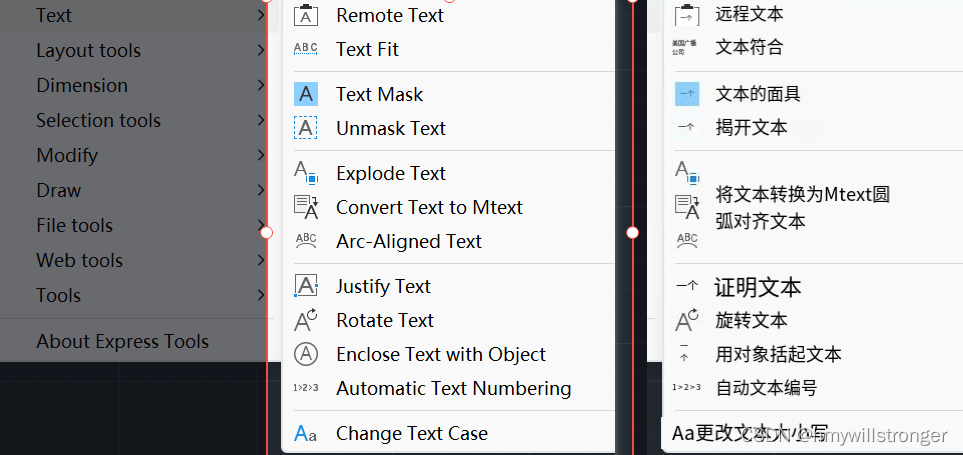
Remote Text
This tool allows you to move the text to a new location while maintaining its original alignment and orientation. Select the text, specify the new insertion point, and the text will be moved accordingly.
Text Fit
Use this tool to fit text within a specified width. Select the text, enter the desired width, and the text will be resized to fit within that width.
Text Mask
This tool creates a mask behind the text, making it more readable on complex backgrounds. Select the text, specify the mask offset and color, and a mask will be created.
Unmask Text
Use this tool to remove the mask created by the Text Mask tool. Select the masked text, and the mask will be removed.
Explode Text
This tool converts text into polylines, allowing you to edit the individual characters. Select the text and choose the Explode Text option to convert it into polylines.
Convert Text to Mtext
Use this tool to convert single-line text to multiline text (Mtext). Select the single-line text, and it will be converted to an Mtext object.
Arc-Aligned Text
This tool creates text that follows an arc path. Select the arc, specify the text parameters (height, style, etc.), and the text will be created along the arc.
Justify Text
Use this tool to justify text within a specified width. Select the text, enter the desired width, and choose the justification option (left, center, or right).
Rotate Text
This tool allows you to rotate text by a specified angle. Select the text, enter the rotation angle, and the text will be rotated accordingly.
Enclose Text with Object
Use this tool to create a boundary around the text. Select the text, choose the boundary shape (rectangle, circle, etc.), and specify the offset distance.
Automatic Text Numbering
This tool automatically numbers selected text objects. Select the text objects, specify the starting number and increment, and the text will be numbered accordingly.
Change Text Case
Use this tool to change the case of selected text objects (uppercase, lowercase, or title case). Select the text objects and choose the desired case option.
To access these tools, you need to have the Express Tools installed and loaded in AutoCAD. Once loaded, you can find these tools in the Express Tools tab or by typing their respective commands in the AutoCAD command line.
Remember to refer to the Autodesk documentation or online resources for more detailed information on using these tools effectively in your AutoCAD workflow.
Layout tools
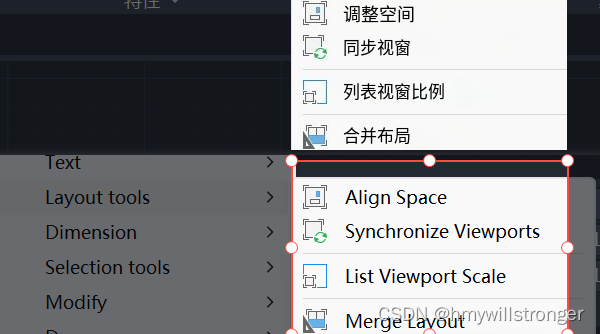
Align Space
This tool allows you to align the model space and paper space viewports in your layout. It ensures that the viewports are precisely aligned with each other or with the layout edges, making it easier to create consistent and professional-looking layouts.
Synchronize Viewports
Use this tool to synchronize the view settings of multiple viewports in a layout. It allows you to apply the same zoom level, pan position, and other view properties to selected viewports simultaneously. This is particularly useful when you need to maintain consistent views across different viewports.
List Viewport Scale
This tool provides a convenient way to list and manage the scales of viewports in your layout. It displays a dialog box that shows the current scale of each viewport and allows you to quickly modify the scales as needed. This can be helpful when you need to ensure that viewports are set to specific scales or when you want to maintain consistent scaling across multiple viewports.
Merge Layout
Use this tool to merge the contents of one layout into another. It allows you to select a source layout and a destination layout, and then transfers all the objects, viewports, and settings from the source layout to the destination layout. This can be useful when you need to consolidate multiple layouts into a single layout or when you want to combine elements from different layouts.
Dimension
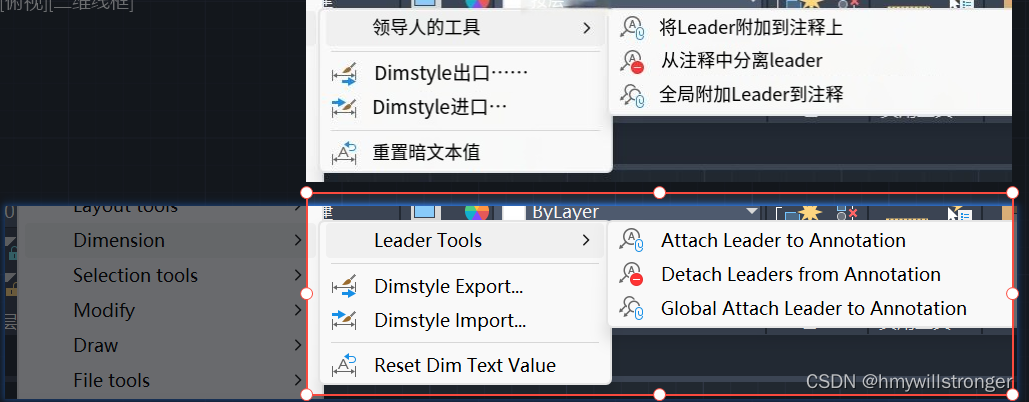
Leader Tools
The Leader Tools in Autodesk Express Tools provide a set of functions to enhance your workflow when working with leaders and annotations in AutoCAD. Some of the key tools include:
-
Attach Leader to Annotation: This tool allows you to associate a leader line with an annotation object, such as a text or a dimension. When the annotation is moved, the leader line will automatically update its position to maintain the connection.
-
Detach Leaders from Annotation: Use this tool to remove the association between a leader line and an annotation object. This can be useful when you need to modify the leader or the annotation independently.
-
Global Attach Leader to Annotation: This tool enables you to associate multiple leader lines with their corresponding annotation objects in a single operation. It saves time and effort when you have numerous leaders and annotations to connect.
Dimstyle Export…
This tool allows you to export dimension styles from your current drawing to an external file. It creates a file with a .dimx extension that contains all the settings and properties of the selected dimension styles. This is useful for sharing dimension styles across different drawings or backing up your custom styles.
Dimstyle Import…
Use this tool to import dimension styles from an external file (.dimx) into your current drawing. It allows you to bring in previously saved or shared dimension styles, saving you the effort of recreating them from scratch. This is particularly helpful when you need to maintain consistent dimension styles across multiple drawings.
Reset Dim Text Value
This tool enables you to reset the text values of selected dimensions to their original measured values. It removes any manual overrides or edits made to the dimension text and restores the actual measured values based on the dimension properties. This can be useful when you want to quickly revert dimensions to their true values after making adjustments.
Selection tools

Get Selection Set (GETSEL)
The Get Selection Set (GETSEL) tool in Autodesk Express Tools allows you to create and manage named selection sets in AutoCAD. A selection set is a group of objects that you can select and manipulate as a single entity. This tool provides a convenient way to store and recall specific sets of objects for future use.
With the GETSEL tool, you can:
- Create a new selection set by selecting objects in your drawing.
- Add or remove objects from an existing selection set.
- Rename or delete selection sets.
- Recall a previously created selection set to quickly select the objects it contains.
Using selection sets can be beneficial when you need to work with specific groups of objects repeatedly. Instead of manually selecting the objects each time, you can simply recall the selection set and have all the objects selected instantly.
Fast Select (FSELECT)
The Fast Select (FSELECT) tool in Autodesk Express Tools provides an enhanced object selection method in AutoCAD. It allows you to quickly select objects based on various criteria, such as object type, layer, color, linetype, and more.
With the FSELECT tool, you can:
- Choose from a wide range of selection criteria to filter objects in your drawing.
- Combine multiple criteria using logical operators (AND, OR) to refine your selection.
- Save and load selection criteria for future use.
- Select objects that match the specified criteria with a single click.
The FSELECT tool is particularly useful when you need to select a specific subset of objects based on their properties. It saves time and effort compared to manual selection methods, especially in complex drawings with numerous objects.
Both the GETSEL and FSELECT tools are part of the Autodesk Express Tools collection and are designed to enhance your object selection capabilities in AutoCAD. They provide efficient ways to create, manage, and recall selection sets
Modify

Multiple Object Stretch
The Multiple Object Stretch tool in Autodesk Express Tools allows you to stretch multiple objects simultaneously in AutoCAD. It extends the functionality of the standard stretch command by enabling you to select and stretch objects that are not typically stretchable, such as circles, text, and blocks.
With the Multiple Object Stretch tool, you can:
- Select multiple objects, including those that are not normally stretchable.
- Define the stretch frame and specify the base point and displacement.
- Stretch all selected objects, maintaining their relative positions and sizes.
This tool is particularly useful when you need to modify the size or shape of complex drawings that contain a mix of stretchable and non-stretchable objects.
Move/Copy/Rotate
The Move/Copy/Rotate tool in Autodesk Express Tools combines three commonly used editing operations into a single command. It allows you to move, copy, or rotate selected objects in a single step, streamlining your workflow.
With the Move/Copy/Rotate tool, you can:
- Select the objects you want to modify.
- Choose whether to move, copy, or rotate the selected objects.
- Specify the base point and destination point (for move and copy) or the rotation angle (for rotate).
- Adjust the settings, such as the number of copies or the rotation reference point.
This tool saves time and effort by consolidating multiple editing operations into a single command, reducing the need to switch between different commands.
Extended Clip
The Extended Clip tool in Autodesk Express Tools enhances the functionality of the standard CLIP command in AutoCAD. It allows you to clip xrefs, images, and underlays using a specified boundary, while maintaining the ability to snap to the original geometry.
With the Extended Clip tool, you can:
- Select the xref, image, or underlay you want to clip.
- Specify the clipping boundary using points, polylines, or other objects.
- Adjust the clipping settings, such as the clipping type (rectangular or polygonal) and the hiding of the clipped area.
- Clip the selected object while preserving the ability to snap to its original geometry.
This tool is useful when you need to focus on specific areas of an xref, image, or underlay while still being able to reference the original data.
Convert Shape to Block
The Convert Shape to Block tool in Autodesk Express Tools allows you to convert a closed shape, such as a polyline or a region, into a block definition. This is useful when you want to create reusable block symbols from existing geometry.
With the Convert Shape to Block tool, you can:
- Select the closed shape you want to convert into a block.
- Specify the insertion point for the new block.
- Enter a name for the new block definition.
- Choose whether to delete or retain the original shape after the conversion.
This tool streamlines the process of creating custom block symbols from existing geometry, saving you time and effort compared to manually creating block definitions.
DrawOrder by Color
The DrawOrder by Color tool in Autodesk Express Tools allows you to change the draw order of objects based on their color. It enables you to bring objects of a specific color to the front or send them to the back of the drawing order.
With the DrawOrder by Color tool, you can:
- Select the objects you want to modify the draw order for.
- Choose the color of the objects you want to bring to the front or send to the back.
- Specify whether to bring the selected color to the front or send it to the back.
- Adjust the draw order of objects based on their color.
This tool is helpful when you need to prioritize the visibility of objects based on their color, ensuring that important elements are not obscured by others.
Flatten Objects
The Flatten Objects tool in Autodesk Express Tools allows you to flatten 3D objects into 2D representations. It converts 3D solids, polylines, and other objects into planar geometries that lie on the current UCS (User Coordinate System) plane.
With the Flatten Objects tool, you can:
- Select the 3D objects you want to flatten.
- Specify the flatten settings, such as the target UCS and the handling of hidden lines.
- Flatten the selected objects into 2D representations.
This tool is useful when you need to create 2D views or sections of 3D models, or when you want to simplify complex 3D geometry for plotting or further editing.
Multiple Copy
The Multiple Copy tool in Autodesk Express Tools allows you to create multiple copies of selected objects in a single operation. It provides a convenient way to duplicate objects along a path or in a grid pattern.
With the Multiple Copy tool, you can:
- Select the objects you want to copy.
- Choose the copy method (linear, grid, or polar).
- Specify the copy settings, such as the number of copies, spacing, and rotation angle.
- Create multiple copies of the selected objects based on the specified settings.
This tool streamlines the process of creating repetitive copies of objects, saving you time and effort compared to manually copying and placing each instance.
Extended Offset
The Extended Offset tool in Autodesk Express Tools enhances the functionality of the standard OFFSET command in AutoCAD. It allows you to offset objects at a specified distance and provides additional options for offsetting arcs, circles, and polylines.
With the Extended Offset tool, you can:
- Select the objects you want to offset.
- Specify the offset distance and direction.
- Choose the offset options, such as the handling of arcs, circles, and polylines.
- Create offset copies of the selected objects based on the specified settings.
This tool extends the capabilities of the standard offset command, providing more flexibility and control over the offsetting process.
These tools are part of the Autodesk Express Tools collection and are designed to enhance your productivity and streamline common editing tasks in AutoCAD. They offer additional functionality and options beyond the standard AutoCAD commands, allowing you to work more efficiently and achieve desired results with fewer steps. As mentioned earlier, ensure that you have the Express Tools installed and loaded in your AutoCAD environment to access these features.
Draw

Break-line Symbol
The Break-line Symbol tool in Autodesk Express Tools allows you to create break-line symbols in your AutoCAD drawings. Break-line symbols are used to indicate the intentional omission or interruption of a portion of a line or object, often to improve the clarity or readability of the drawing.
With the Break-line Symbol tool, you can:
- Select the line or object where you want to insert the break-line symbol.
- Specify the length and style of the break-line symbol.
- Choose the orientation and placement of the break-line symbol relative to the selected line or object.
- Insert the break-line symbol at the specified location.
This tool automates the process of creating break-line symbols, ensuring consistent and accurate placement while saving time compared to manually drawing and inserting the symbols.
SuperHatch
The SuperHatch tool in Autodesk Express Tools extends the functionality of the standard HATCH command in AutoCAD. It provides additional options and features for creating and managing hatch patterns in your drawings.
With the SuperHatch tool, you can:
- Create hatch patterns using predefined or custom hatch definitions.
- Apply hatch patterns to closed areas or selected objects.
- Modify hatch pattern properties, such as scale, angle, and origin.
- Edit and update existing hatch patterns.
- Create gradient fills and solid fills.
- Generate associative hatch patterns that update automatically when the boundary objects are modified.
The SuperHatch tool enhances the capabilities of the standard hatch command, offering more flexibility and control over the creation and editing of hatch patterns. It allows you to create visually appealing and informative hatch patterns with ease.
Some key features of the SuperHatch tool include:
- Support for multiple hatch patterns and gradient fills in a single operation.
- Ability to create hatch patterns from custom hatch definitions.
- Options to control the hatch pattern origin, scale, and angle.
- Associative hatch patterns that update automatically when the boundary objects are modified.
- Improved performance and speed compared to the standard hatch command.
The SuperHatch tool is particularly useful when you need to create complex or custom hatch patterns, apply hatch patterns to multiple areas simultaneously, or maintain associativity between hatch patterns and their boundary objects.
These tools are part of the Autodesk Express Tools collection and are designed to streamline specific tasks and enhance the functionality of AutoCAD. They provide additional options and automation capabilities that can save time and improve the quality of your drawings. As mentioned earlier, ensure that you have the Express Tools installed and loaded in your AutoCAD environment to access these features.
File tools
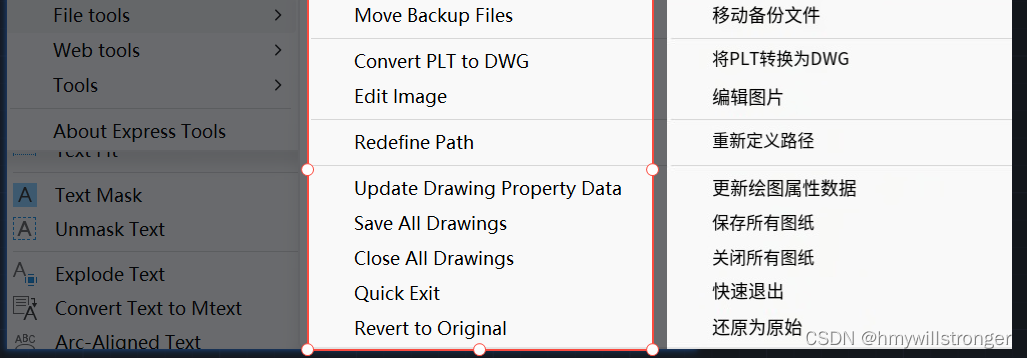
Move Backup Files
The Move Backup Files tool in Autodesk Express Tools allows you to manage and relocate backup files created by AutoCAD. When AutoCAD creates backup files, they are typically stored in the same directory as the original drawing files. This tool enables you to move the backup files to a different location, helping you organize and declutter your drawing folders.
With the Move Backup Files tool, you can:
- Specify the source directory where the backup files are currently located.
- Choose the destination directory where you want to move the backup files.
- Select the backup file types to move (e.g., .bak, .dwl).
- Initiate the move operation to transfer the backup files to the specified destination.
This tool is useful for maintaining a tidy and organized file structure, separating backup files from the original drawing files.
Convert PLT to DWG
The Convert PLT to DWG tool in Autodesk Express Tools allows you to convert PLT (plot) files to DWG (drawing) format. PLT files are plot files generated by AutoCAD or other CAD software, while DWG files are the native drawing format used by AutoCAD.
With the Convert PLT to DWG tool, you can:
- Select the PLT file(s) you want to convert.
- Specify the output directory where the converted DWG files will be saved.
- Choose the conversion options, such as the target DWG version and the handling of plot styles.
- Convert the PLT files to DWG format.
This tool is useful when you need to edit or modify the content of a PLT file, as PLT files are typically read-only and cannot be directly edited in AutoCAD.
Edit Image
The Edit Image tool in Autodesk Express Tools allows you to edit raster images attached to your AutoCAD drawings. It provides a set of image editing tools directly within the AutoCAD environment, eliminating the need to use external image editing software.
With the Edit Image tool, you can:
- Select the raster image you want to edit.
- Access various image editing tools, such as crop, rotate, scale, and adjust brightness/contrast.
- Apply filters and effects to enhance the image appearance.
- Modify the image properties, such as transparency and clipping boundary.
- Save the edited image back to the drawing or export it to an external file format.
This tool is useful when you need to make quick adjustments or modifications to raster images directly within AutoCAD, saving time and effort compared to using separate image editing software.
Redefine Path
The Redefine Path tool in Autodesk Express Tools allows you to update and manage file paths associated with external references (xrefs), images, and other linked files in your AutoCAD drawings. When drawings are moved or shared between different systems, the file paths of linked files may become invalid, causing missing or unresolved references.
With the Redefine Path tool, you can:
- Select the drawings or folders containing the drawings you want to update.
- Specify the old file path that needs to be replaced.
- Enter the new file path to be used instead.
- Update the file paths of xrefs, images, and other linked files in the selected drawings.
This tool streamlines the process of updating file paths, ensuring that external references and linked files remain properly connected to your drawings.
Update Drawing Property Data
The Update Drawing Property Data tool in Autodesk Express Tools allows you to update and synchronize the property data of your AutoCAD drawings. Property data includes information such as title, author, subject, keywords, and custom properties that are associated with the drawing files.
With the Update Drawing Property Data tool, you can:
- Select the drawings or folders containing the drawings you want to update.
- Specify the property data fields you want to update (e.g., title, author, subject).
- Enter the new values for the selected property data fields.
- Update the property data of the selected drawings.
This tool is useful for maintaining consistent and accurate property data across multiple drawings, especially when working on large projects or collaborating with others.
Save All Drawings
The Save All Drawings tool in Autodesk Express Tools allows you to save all open drawings in AutoCAD with a single command. Instead of manually saving each drawing individually, this tool provides a quick and convenient way to save multiple drawings at once.
With the Save All Drawings tool, you can:
- Initiate the command to save all open drawings.
- Optionally, specify a different file format or version for the saved drawings.
- Save all open drawings to their respective file locations.
This tool is particularly useful when working with multiple drawings simultaneously and wanting to ensure that all changes are saved before closing AutoCAD or moving on to other tasks.
Close All Drawings
The Close All Drawings tool in Autodesk Express Tools allows you to close all open drawings in AutoCAD with a single command. Instead of manually closing each drawing individually, this tool provides a quick and convenient way to close multiple drawings at once.
With the Close All Drawings tool, you can:
- Initiate the command to close all open drawings.
- Optionally, specify whether to save changes to the drawings before closing.
- Close all open drawings in AutoCAD.
This tool is useful when you have finished working with multiple drawings and want to clean up your workspace or free up system resources.
Quick Exit
The Quick Exit tool in Autodesk Express Tools allows you to quickly exit AutoCAD without going through the standard exit procedure. It bypasses the prompts and dialog boxes that typically appear when closing AutoCAD, providing a faster way to exit the program.
With the Quick Exit tool, you can:
- Initiate the command to quickly exit AutoCAD.
- Optionally, specify whether to save changes to the open drawings before exiting.
- Exit AutoCAD immediately without any additional prompts.
This tool is useful when you need to close AutoCAD quickly or want to streamline the exit process, especially when working with multiple drawings or in a fast-paced environment.
Revert to Original
The Revert to Original tool in Autodesk Express Tools allows you to discard all changes made to a drawing and revert it back to its original state. This tool is useful when you want to undo all modifications and start over from the last saved version of the drawing.
With the Revert to Original tool, you can:
- Select the drawing you want to revert to its original state.
- Initiate the command to revert the drawing.
- Confirm the action to discard all changes and revert the drawing to its original saved state.
This tool provides a quick way to discard unwanted changes and restore a drawing to its previous saved state, saving time compared to manually undoing multiple actions or closing and reopening the drawing.
These tools are part of the Autodesk Express Tools collection and are designed to enhance productivity, streamline workflows, and provide additional functionality in AutoCAD. They offer convenient and efficient ways to manage files, convert formats, edit images, update properties, and perform common actions like saving and closing drawings.
Web tools
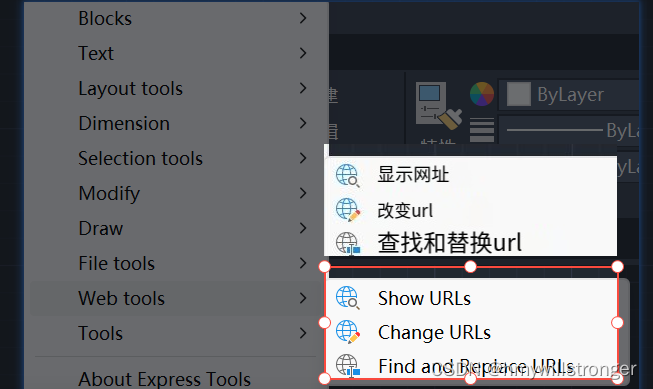
Show URLs
The Show URLs tool in Autodesk Express Tools allows you to display and manage the URLs (Uniform Resource Locators) associated with hyperlinks in your AutoCAD drawings. Hyperlinks are clickable links embedded in drawings that can open web pages, files, or other resources when clicked.
With the Show URLs tool, you can:
- Initiate the command to display all the URLs in the current drawing.
- View a list of all the hyperlinks and their associated URLs.
- Select individual hyperlinks from the list to zoom to their location in the drawing.
- Access additional options, such as editing or removing hyperlinks.
This tool is useful for reviewing and managing the hyperlinks in your drawings, especially when you need to verify or update the linked resources.
Change URLs
The Change URLs tool in Autodesk Express Tools allows you to modify the URLs associated with hyperlinks in your AutoCAD drawings. This tool is particularly useful when you need to update the linked resources or change the destination of multiple hyperlinks simultaneously.
With the Change URLs tool, you can:
- Initiate the command to change the URLs of hyperlinks in the current drawing.
- Specify the old URL or a portion of the URL that you want to replace.
- Enter the new URL or the replacement text for the specified portion of the URL.
- Apply the changes to update the URLs of the selected hyperlinks.
This tool streamlines the process of updating hyperlinks, saving time and effort compared to manually editing each hyperlink individually.
Find and Replace URLs
The Find and Replace URLs tool in Autodesk Express Tools allows you to search for specific URLs or portions of URLs in your AutoCAD drawings and replace them with new values. This tool is useful when you need to update multiple hyperlinks based on a specific search criteria.
With the Find and Replace URLs tool, you can:
- Initiate the command to find and replace URLs in the current drawing.
- Specify the search criteria, such as the exact URL or a portion of the URL you want to find.
- Enter the replacement URL or the new value for the specified search criteria.
- Set additional options, such as case sensitivity or whole word matching.
- Find and replace the URLs that match the specified search criteria.
This tool provides a powerful way to search and replace URLs in your drawings, enabling you to quickly update multiple hyperlinks based on specific patterns or criteria.
These tools are part of the Autodesk Express Tools collection and are designed to enhance the management and manipulation of hyperlinks and URLs in AutoCAD drawings. They provide convenient ways to display, modify, and search for URLs, streamlining the process of working with hyperlinks in your drawings.
Hyperlinks can be a valuable addition to your AutoCAD drawings, allowing you to link to external resources, provide additional information, or navigate to specific views or locations within the drawing. The Show URLs, Change URLs, and Find and Replace URLs tools in Express Tools make it easier to work with hyperlinks and ensure that the linked resources remain accurate and up to date.
Tools
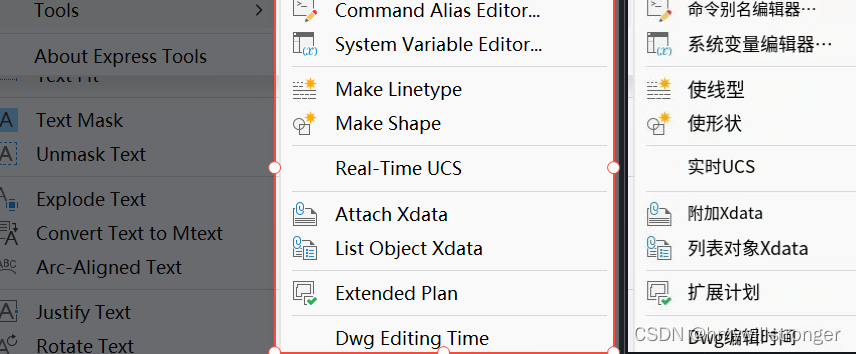
Command Alias Editor
The Command Alias Editor in Autodesk Express Tools allows you to create, modify, and manage command aliases in AutoCAD. Command aliases are shortened or alternative names that you can assign to AutoCAD commands, making it faster and more convenient to execute frequently used commands.
With the Command Alias Editor, you can:
- Create new command aliases by specifying the alias name and the corresponding AutoCAD command.
- Modify existing command aliases by changing the alias name or the associated command.
- Delete unwanted command aliases.
- Import and export command alias definitions for sharing or backup purposes.
This tool is useful for customizing your AutoCAD environment and streamlining your workflow by creating shortcuts for commonly used commands.
System Variable Editor
The System Variable Editor in Autodesk Express Tools provides a centralized interface for viewing and modifying AutoCAD system variables. System variables are settings that control various aspects of AutoCAD’s behavior and functionality.
With the System Variable Editor, you can:
- View a comprehensive list of AutoCAD system variables and their current values.
- Search for specific system variables based on their name or description.
- Modify the values of system variables directly within the editor.
- Save and load system variable configurations for different projects or workflows.
This tool is useful for managing and customizing AutoCAD’s settings, especially when you need to quickly access and modify multiple system variables.
Make Linetype
The Make Linetype tool in Autodesk Express Tools allows you to create custom linetypes in AutoCAD. Linetypes define the pattern and appearance of lines in your drawings, such as dashed, dotted, or custom patterns.
With the Make Linetype tool, you can:
- Create new linetypes by specifying the linetype name and definition.
- Define the linetype pattern using a combination of dashes, dots, and spaces.
- Set the scale factor and description for the linetype.
- Save the custom linetype for use in your drawings.
This tool is useful for creating specific linetype patterns that are not available in the default AutoCAD linetype library.
Make Shape
The Make Shape tool in Autodesk Express Tools allows you to create custom shapes in AutoCAD. Shapes are reusable geometry that can be inserted into your drawings as symbols or markers.
With the Make Shape tool, you can:
- Create new shapes by drawing the desired geometry using AutoCAD’s drawing tools.
- Specify the insertion point and base point for the shape.
- Set the shape name and description.
- Save the custom shape for use in your drawings.
This tool is useful for creating custom symbols, logos, or markers that are not available in the default AutoCAD shape library.
Real-Time UCS
The Real-Time UCS tool in Autodesk Express Tools allows you to dynamically manipulate the User Coordinate System (UCS) in 3D space. The UCS defines the orientation and origin of the coordinate system in AutoCAD.
With the Real-Time UCS tool, you can:
- Interactively rotate and reposition the UCS using your pointing device.
- Align the UCS with existing geometry or specific viewpoints.
- Save and recall UCS positions for quick access.
This tool is particularly useful when working in 3D environments, as it provides an intuitive way to orient the UCS for drawing and editing purposes.
Attach Xdata
The Attach Xdata tool in Autodesk Express Tools allows you to attach extended data (Xdata) to objects in your AutoCAD drawings. Xdata is custom data that can be associated with objects to store additional information or attributes.
With the Attach Xdata tool, you can:
- Select the objects to which you want to attach Xdata.
- Specify the Xdata application name and the data to be attached.
- Attach the Xdata to the selected objects.
This tool is useful for adding custom metadata or information to objects in your drawings, which can be used for data management, analysis, or integration with other systems.
List Object Xdata
The List Object Xdata tool in Autodesk Express Tools allows you to view and manage the extended data (Xdata) attached to objects in your AutoCAD drawings.
With the List Object Xdata tool, you can:
- Select the objects for which you want to list the attached Xdata.
- View a list of all the Xdata applications and their associated data for the selected objects.
- Modify or remove Xdata from the selected objects.
This tool is useful for reviewing and managing the custom data attached to objects in your drawings.
Extended Plan
The Extended Plan tool in Autodesk Express Tools is a layout planning tool that allows you to create and manipulate 2D floor plans in AutoCAD. It provides a simplified interface and automated tools for designing and documenting architectural floor plans.
With the Extended Plan tool, you can:
- Create walls, doors, windows, and other architectural elements using predefined commands and options.
- Modify and edit the floor plan elements using intuitive grips and editing tools.
- Manage layers, properties, and styles for the floor plan elements.
- Generate schedules, annotations, and dimensions for the floor plan.
This tool is particularly useful for architects, designers, and drafters working on 2D architectural projects, as it streamlines the process of creating and documenting floor plans.
DWG Editing Time
The DWG Editing Time tool in Autodesk Express Tools allows you to track and display the editing time spent on your AutoCAD drawings. It provides a convenient way to monitor the time invested in working on specific drawings.
With the DWG Editing Time tool, you can:
- Enable or disable the editing time tracking for the current drawing.
- View the total editing time spent on the drawing, including the current session and previous sessions.
- Reset the editing time counter if needed.
This tool is useful for project management, time tracking, and productivity analysis purposes, helping you understand the time invested in different drawings or tasks.
These tools are part of the Autodesk Express Tools collection and are designed to enhance your productivity, customize your AutoCAD environment, and provide additional functionality for specific tasks or workflows. They offer features and capabilities beyond the standard AutoCAD commands, allowing you to work more efficiently and effectively.





















 1647
1647











 被折叠的 条评论
为什么被折叠?
被折叠的 条评论
为什么被折叠?










